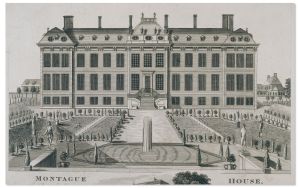
This day in London history: on 15 January 1759 the British Museum first opened to the public, following a 1753 Act of Parliament to establish the museum. The early exhibits were collections once belonging to Sir Hans Sloane who wanted the 70,000-plus objects he had collected in his lifetime to be preserved intact. He bequeathed his entire collection to King George II for the nation in return for a payment of £20,000 to his heirs.
 The museum was first housed in a seventeenth-century mansion, Montagu House, in Bloomsbury on the site of today’s building. Entry was free and given to “all studious and curious Persons” of which there were some 5,000 a year; it remains free today to the six million people who visit it every year.
The museum was first housed in a seventeenth-century mansion, Montagu House, in Bloomsbury on the site of today’s building. Entry was free and given to “all studious and curious Persons” of which there were some 5,000 a year; it remains free today to the six million people who visit it every year.
In addition to being a collector, the Irish-born Sloane was a physician and naturalist. He was a member of the Royal Society, and a fellow of the College of Physicians, under the auspices of which he travelled to Jamaica. There is he discovered a local drink, cocoa, which he found nauseating, but made more palatable by mixing it with milk rather than the customary water. He brought it back to England, where it was originally manufactured and sold by apothecaries as a medicine.
 The Worshipful Society of Apothecaries of London is one of the livery companies of the City of London and was founded by Royal Charter in 1617. The Company founded the Chelsea Physic Garden was in 1673, as the Apothecaries’ Garden, with the purpose of training apprentices in identifying plants. Sloane, who had purchased the Manor of Chelsea, comprising four acres of land, from Charles Cheyne, leased the land to the Society of Apothecaries for £5 a year in perpetuity.
The Worshipful Society of Apothecaries of London is one of the livery companies of the City of London and was founded by Royal Charter in 1617. The Company founded the Chelsea Physic Garden was in 1673, as the Apothecaries’ Garden, with the purpose of training apprentices in identifying plants. Sloane, who had purchased the Manor of Chelsea, comprising four acres of land, from Charles Cheyne, leased the land to the Society of Apothecaries for £5 a year in perpetuity.

In 1983 the Garden became a registered charity and was opened to the general public for the first time. The public entrance is on Swan Walk, which takes its name from a tavern sign; the swan was a common sign for inns, partly because it featured on Henry IV’s coat of arms, and it was especially popular for waterside inns. This Chelsea inn was a common gathering ground for the fashionable set of 17th-century London, of whom Samuel Pepys was one.

The Swan was also the finishing post for the famous Doggett Coat and Badge race – the oldest annually contested event in the British sporting calendar. Thomas Doggett was an actor, singer, and player at the Drury Lane Theatre, and founded the race in 1716 in honour of George I’s accession to the throne. It provided for six young watermen (who ferried passengers on city centre waterways) to race four-and-a-half miles against the tide; the winner would receive a silver badge and a livery coat.
The race is still held every year, though the qualifications have had to change with the times, there being rather fewer young watermen these days.

7 responses to “Museums, cocoa and boat races”
Ah, Sloane; he and I are recent acquaintances. I had a wee post about the Coat and Badge a long time ago, one of my favourite tales of London – thank you for sharing it!
I trust Sloane is well. Glad you enjoyed my abbreviated version of the race – I’m happy to link to your post if you send the url.
[…] common sign for inns, particularly waterside inns. This Swan was the finishing post for the famous Doggett Coat and Badge race – the oldest annually contested event in the British sporting calendar – a race founded in […]
[…] Physic Garden, which has an entrance in Swan Walk and therefore a connection with the famous Doggett Coat and Badge race, which is organized by the Worshipful Company of […]
[…] Square is named for the physician, naturalist and collector Sir Hans Sloane. Among other achievements, he introduced cocoa to England and bequeathed the 70,000-plus objects in […]
[…] was a common sign for inns, particularly waterside inns. This Swan was the finishing post for the Doggett Coat and Badge […]
[…] Sir Hans, who gives his name to Sloane Square, was a member of the Royal Society, and a fellow of the College of Physicians. The British Museum was founded with his collection, which he had spent much of his life accumulating, and he was responsible for introducing cocoa to England. You can read more about Sir Hans in a post about some of his London connections here. […]